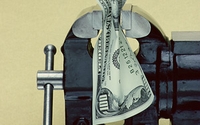February 28, 2015
A proposal to change how businesses can write-off advertising expenses brought leap-to-the-feet unity during yesterday’s NAB State Leadership Conference. "They will trample over ad tax deductibility over my dead body," Senator Chuck Schumer (D-NY) said during a speech at the event, which brought a record 600 broadcasters from across the country to Washington. With Madison Avenue not far from his district office, Schumer’s remarks — enough to earn him one of his standing ovations — weren’t entirely surprising. But it signaled that opponents of an ad tax have an unwavering ally at the very top of Senate Democratic leadership. Schumer also drew rave reviews from broadcasters in the room for his crediting of local radio and TV for remaining on the air when massive snowstorms buried Buffalo under seven feet of snow last November. "Cell phones and electricity went off — broadcasters stayed on," he said. And he praised news operations, calling local broadcasters "the glue of America" in a changing media marketplace. "You are the beating heart of journalism," he said. Schumer also pledged he would "stay on the FCC" to make sure they treat local radio "fairly." Today broadcasters will meet with home state lawmakers to talk issues.
Radio’s digital revenue pie is diversifying. Radio is becoming less reliant on banner advertising and streaming audio ads and tapping more revenue from other digital channels. Though banner ads remain its top digital revenue source, managers surveyed by Borrell Associates forecast their share will drop from 36% in 2014 to 26% this year. Second place streaming audio is on track to dip from 22% to 19% during the same period. "The industry is lessening its dependence on those and significantly increasing advertising from sponsorships, promotions and mobile," CEO Gordon Borrell says. "That’s a good thing because that’s where businesses want to place their marketing dollars." Promotions are poised to grow from 14% of radio’s digital dollars to 16%, program sponsorships are on track to jump from 10% to 14% and mobile is expected to upshift from 1% to 5%. With local marketers buying more of what most stations aren’t selling — search engine optimization, reputation management and social media management — Borrell sees digital diversification at radio as a positive trend. "It allows you to think differently and to follow the money," he says. The practice of selling digital services to local clients is becoming more widespread: more than a third of those surveyed said their stations were either setting up a digital agency, planning to set one up soon, or already had one. Moving beyond banners and streaming opens up a larger pool of digital revenue that can help radio attract a bigger share of the local digital pie. While growing at a double-digit clip, radio’s digital development isn’t keeping pace with the rate at which local businesses are increasing their digital budgets. And that’s continuing to drive radio’s share of local digital ad dollars down.
CMOs are bullish on digital ad budgets. If there’s any doubt radio needs to keep its focus on digital, a survey of chief marketing officers at some of the biggest corporations in America shows that’s where they plan to increase their spending in 2015. Duke University’s biannual CMO Survey shows overall marketing budgets are expected to increase 8.7% this year. But while traditional spending will essentially remain steady (-1.1%) spending on digital marketing is predicted to grow 14.7%. And the CMOs are even more bullish on mobile. The survey shows mobile currently gets about 3.2% of marketing budgets. But that share is expected to triple in the next three years. CMOs reported their most positive outlook since the recession hit six years ago. On an outlook scale of 0 to 100, they came in at 69.9, compared to 47.7 in February 2009. "Marketers are beginning to spend against this optimism," Duke professor and survey director Christine Moorman says.
Ad market to radio: it’s not you, it’s me. Newly-released figures are putting radio’s 2014 revenue into perspective. Core U.S. ad spending grew just 1.6% last year according to Magna Global. That’s the smallest growth rate in six years. Not coincidentally, the RAB reported last week the radio industry also had its first down year in revenue also since 2009. Magna’s chief forecaster Vincent Letang says 2014 was a "disappointing" year for ad spending, pointing out that even with the political and Olympic advertising bonanzas factored in, the ad market grew by a still-modest 3%. Radio spot sales slipped, but it had plenty of company according to the Magna data. Even television revenue declined. Letang calculates across-the-board traditional media spending declined 3.4% last year. At the same time, digital revenue increased 15%. He also points out ad trends didn’t match the overall economic environment, blaming what he calls an "inertia of advertising spending to economic signals." Going forward, he thinks television will take a big hit in 2015 as marketers have taken all they can from radio or print. TV is where the big dollars are ripe for the plucking. "Traditional media budgets will come under increasing pressure because of the diversification of tactics and the opportunities created by digital formats and ‘big data’," he predicts. For radio, Letang last August projected the industry would see a smidgen of growth (+ 0.5%) now he’s a bit less optimistic (-2%) about 2015. But Letang also thinks there’s still a possibility a strengthening economy, lower unemployment rates, and improving business confidence could mean this year will turn out better than expected.





 Historical trends for prime-time TV upfront spending continue to ebb. Media Dynamics, a media consulting company, says the growth of prime-time TV upfront revenue has slowed over the last five years (for the broadcast year 2010-2011 through 2014-2015) from the previous five seasons.
Historical trends for prime-time TV upfront spending continue to ebb. Media Dynamics, a media consulting company, says the growth of prime-time TV upfront revenue has slowed over the last five years (for the broadcast year 2010-2011 through 2014-2015) from the previous five seasons.




